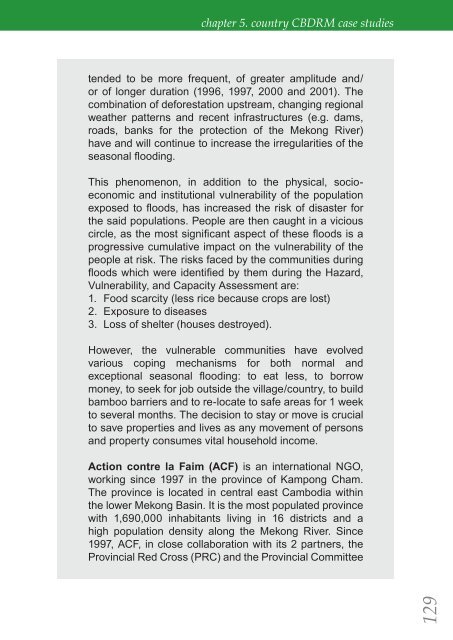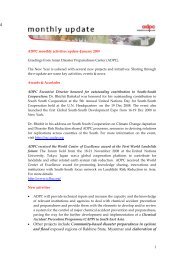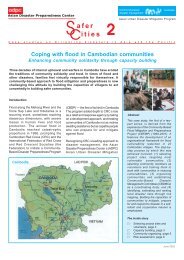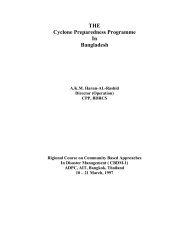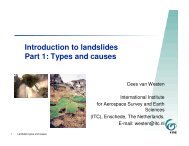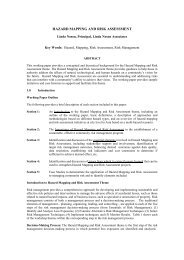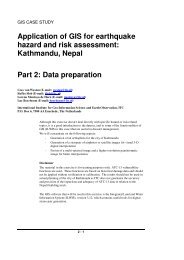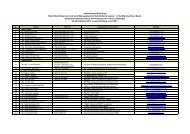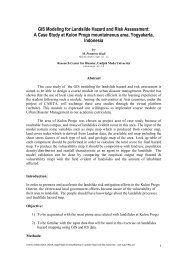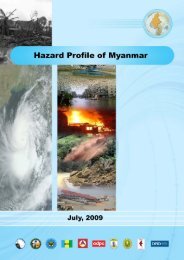community-based disaster risk management and the media media kit
community-based disaster risk management and the media media kit
community-based disaster risk management and the media media kit
Create successful ePaper yourself
Turn your PDF publications into a flip-book with our unique Google optimized e-Paper software.
chapter 5. country CBDRM case studies<br />
tended to be more frequent, of greater amplitude <strong>and</strong>/<br />
or of longer duration (1996, 1997, 2000 <strong>and</strong> 2001). The<br />
combination of deforestation upstream, changing regional<br />
wea<strong>the</strong>r patterns <strong>and</strong> recent infrastructures (e.g. dams,<br />
roads, banks for <strong>the</strong> protection of <strong>the</strong> Mekong River)<br />
have <strong>and</strong> will continue to increase <strong>the</strong> irregularities of <strong>the</strong><br />
seasonal fl ooding.<br />
This phenomenon, in addition to <strong>the</strong> physical, socioeconomic<br />
<strong>and</strong> institutional vulnerability of <strong>the</strong> population<br />
exposed to fl oods, has increased <strong>the</strong> <strong>risk</strong> of <strong>disaster</strong> for<br />
<strong>the</strong> said populations. People are <strong>the</strong>n caught in a vicious<br />
circle, as <strong>the</strong> most signifi cant aspect of <strong>the</strong>se fl oods is a<br />
progressive cumulative impact on <strong>the</strong> vulnerability of <strong>the</strong><br />
people at <strong>risk</strong>. The <strong>risk</strong>s faced by <strong>the</strong> communities during<br />
fl oods which were identifi ed by <strong>the</strong>m during <strong>the</strong> Hazard,<br />
Vulnerability, <strong>and</strong> Capacity Assessment are:<br />
1. Food scarcity (less rice because crops are lost)<br />
2. Exposure to diseases<br />
3. Loss of shelter (houses destroyed).<br />
However, <strong>the</strong> vulnerable communities have evolved<br />
various coping mechanisms for both normal <strong>and</strong><br />
exceptional seasonal fl ooding: to eat less, to borrow<br />
money, to seek for job outside <strong>the</strong> village/country, to build<br />
bamboo barriers <strong>and</strong> to re-locate to safe areas for 1 week<br />
to several months. The decision to stay or move is crucial<br />
to save properties <strong>and</strong> lives as any movement of persons<br />
<strong>and</strong> property consumes vital household income.<br />
Action contre la Faim (ACF) is an international NGO,<br />
working since 1997 in <strong>the</strong> province of Kampong Cham.<br />
The province is located in central east Cambodia within<br />
<strong>the</strong> lower Mekong Basin. It is <strong>the</strong> most populated province<br />
with 1,690,000 inhabitants living in 16 districts <strong>and</strong> a<br />
high population density along <strong>the</strong> Mekong River. Since<br />
1997, ACF, in close collaboration with its 2 partners, <strong>the</strong><br />
Provincial Red Cross (PRC) <strong>and</strong> <strong>the</strong> Provincial Committee<br />
129


